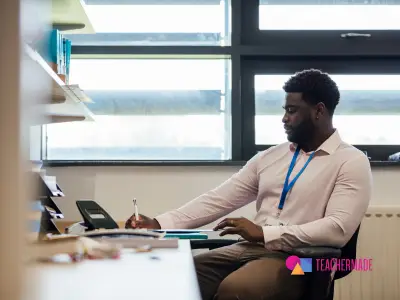Are you looking for the Classworks Special Education program from TouchMath? Click here to go to their site.
Are you looking for the Classworks Special Education program from TouchMath? Click here to go to their site.
If you have spent time with teachers lately, you’ve undoubtedly heard the grumbles about ChatGPT and AI. These concerns are justified – how do we harness technology that will change how students learn forever?
But one of the best ways to understand new tech in the classroom is to jump in with small, low-stakes tasks. This will help you get acclimated to understanding AI’s benefits and limitations. We’ve rounded up 12 strategies to use ChatGPT today in the classroom to save time.

If you’re running low on creativity, you can ask ChatGPT for a lesson plan by giving it a topic or learning standard. Your success depends on context. The more ChatGPT knows about your students’ skills, knowledge, and interests, the more aligned your lesson will be.
If you’re having difficulty establishing relevancy with your students, you might turn to AI for help. For example, if you have a classroom full of TikTokers, you may ask ChatGPT to connect a subject to TikTok. Simple, quick ideas can infuse a lot more engagement into a lesson.
Bringing an abstract concept into the real world can take a lot of work. But that is exactly how we understand abstract theories and concepts deeper. If you’re having trouble creating real-world examples of concepts for your students, try asking for these with AI.
Many teachers don’t trust ChatGPT because the output isn’t always ideal. It seems like you could just do it better and faster without AI. And it’s true, no one can replicate the personal touch of a teacher. Consider trying out ChatGPT for redundant tasks like modifications. If you find yourself making multiple versions of assignments, ask ChatGPT to do it.
ChatGPT understands how to create those practice assignments that help with retrieval. (You know, things like multiplication tables.) You can even get explanations for wrong answers. You can take this further, add the assignment to TeacherMade, and save the feedback to copy and paste after auto-grading.
It’s time-consuming to condense material down for a presentation. But AI excels at summarizing. Ask ChatGPT to take text and learning targets and turn it into an outline. You can also ask it to come up with text that you quickly put onto Slides for presentations.
Giving detailed feedback to students is time-consuming, but is so effective. You can ask ChatGPT to write detailed responses explaining how they can improve. If your students need to go into more detail in their written explanation, you can ask ChatGPT to write feedback that coaches them on how to give more detail.
After a long day of teaching, you return to your desk to see a stack of emails that need responses. You may not have enough mental energy to practice the necessary patience, but ChatGPT does. You can copy and paste the email into ChatGPT and ask it to respond as a “patient teacher” or a “collaborative colleague.” From there, tweak it to fit your needs.
Show your students that assessment can match their classroom and real-world experiences. If you don’t love the test questions you have, try putting them into ChatGPT and giving directions on how to tweak it.
If you have a couple of questions you like but need more, ChatGPT can also use those as a model.
Positive examples of student work are so useful for modeling for students. The problem is that you don’t have student examples when you’re trying a new assignment. You can use AI to generate examples at the level of your students. Simply ask for an example of a student’s answer to a question that reads like a 6th grader wrote it.
Rubrics are one of the most useful tools you and your students use. It allows you to grade transparently but also gives your students a tool on how to do their best. The problem is they can be hard to do well. Rubrics work best if you create them for specific assignments. ChatGPT can make rubrics for essays and open-response questions. ChatGPT can even format it into a chart that is easy to understand.
So many AI tutoring companies are popping up and with good reason. ChatGPT is excellent for tutoring and coaching. A teacher’s superpower is understanding how to break down knowledge into smaller pieces so that it’s more teachable. ChatGPT can assist in this process as a tutor. Use it to help you break down bigger concepts.
TeacherMade helps make your AI-generated teaching materials more accessible. Once you have created learning resources in ChatGPT, use TeacherMade as a platform to distribute materials to your students.
TeacherMade turns your PDFs, Word Docs, and AI materials into auto-graded online activities.